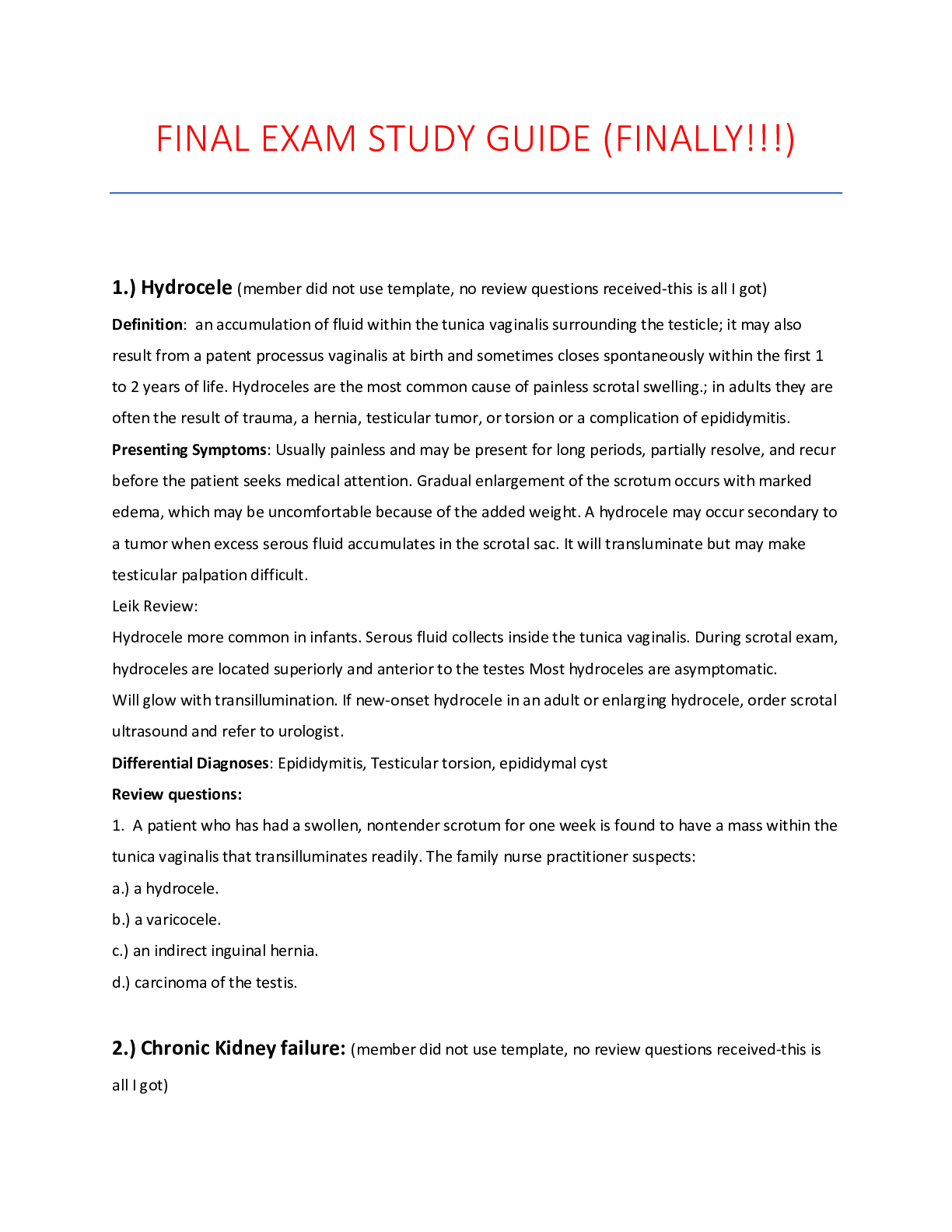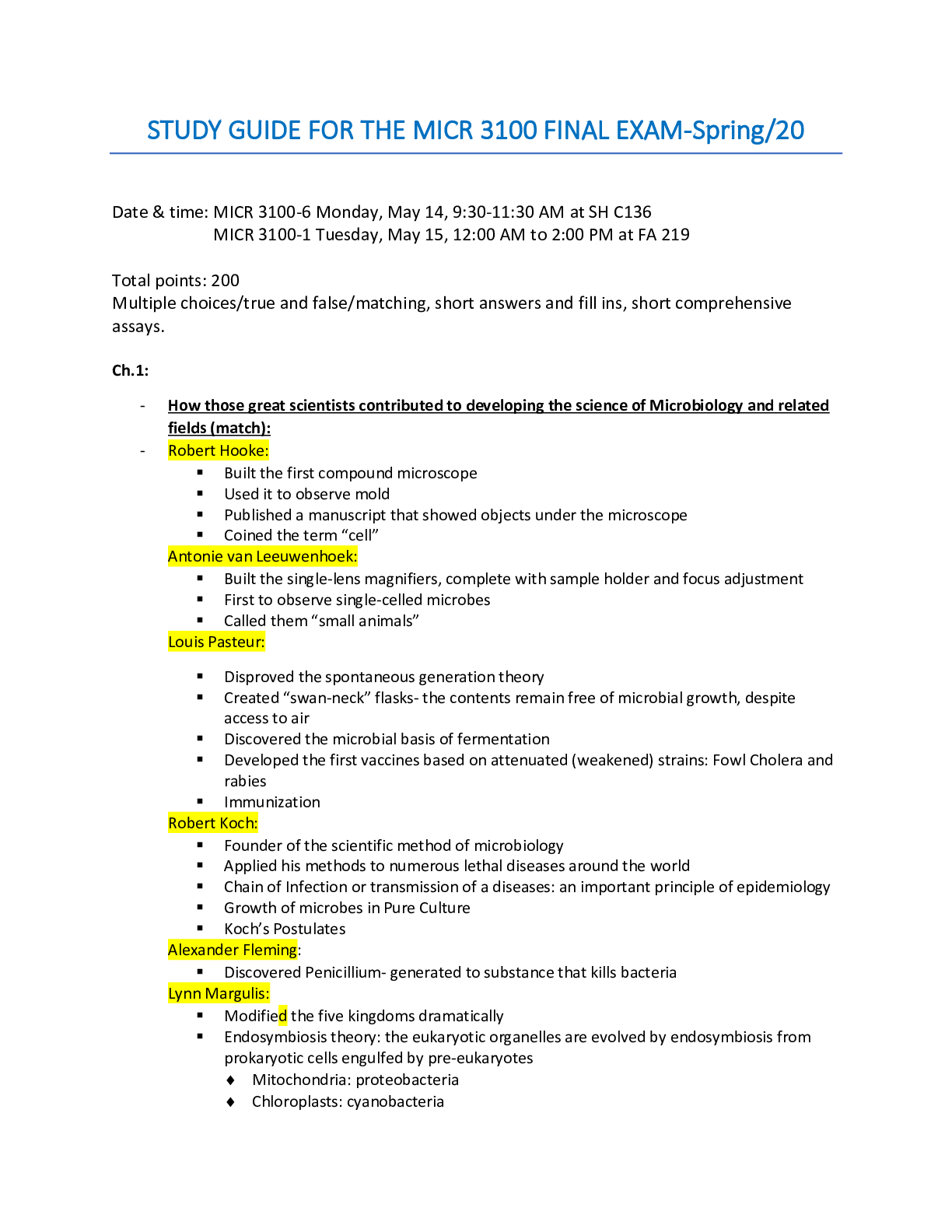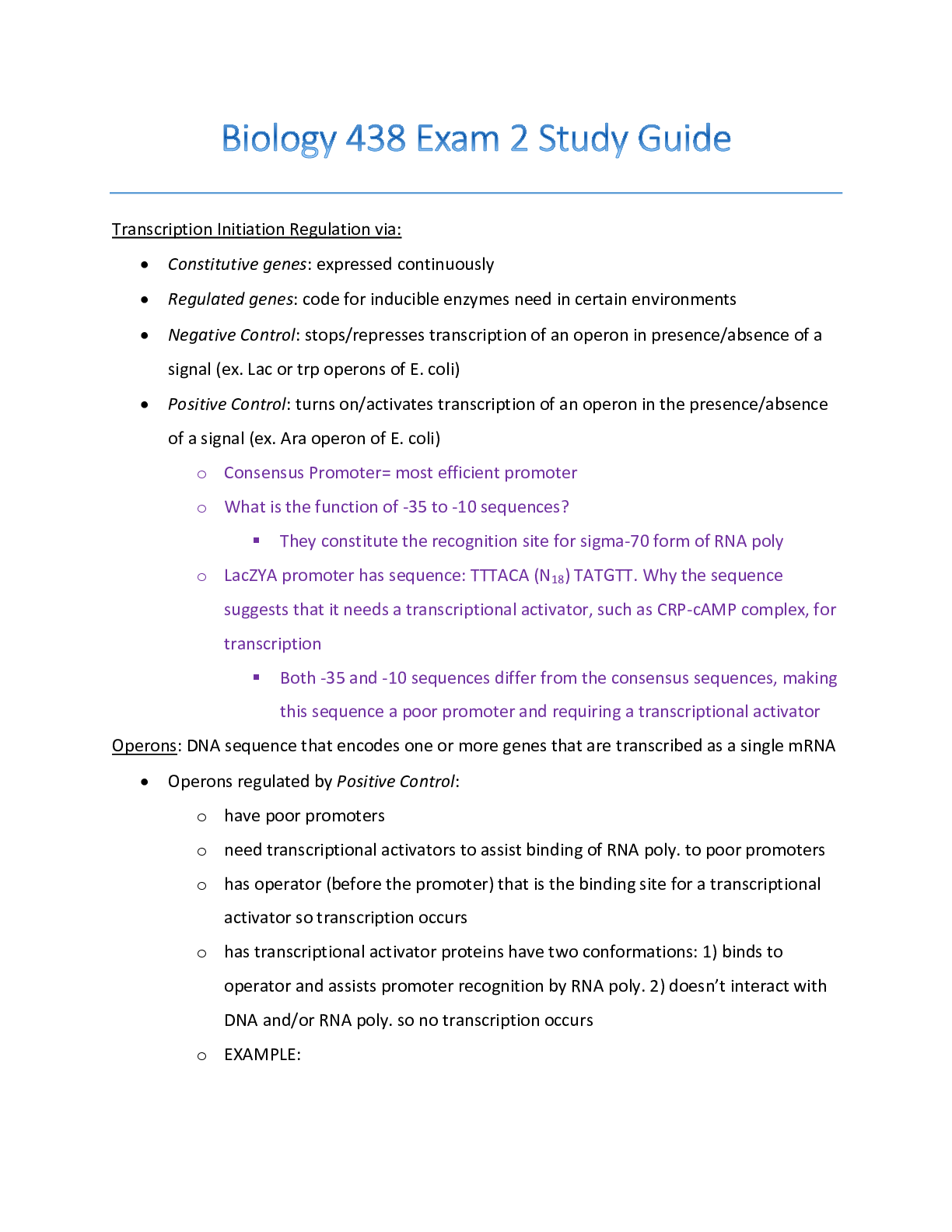Architecture > STUDY GUIDE > ARCH7031 Architectural Practice: Business Management MODULE 11: Consultant engagement (All)
ARCH7031 Architectural Practice: Business Management MODULE 11: Consultant engagement
Document Content and Description Below
MODULE 11: Consultant engagement 11.1 Module outline Aim To familiarise students with consultant engagement for an architectural practice. Objectives On completion of this learning module student... s should be able to: • discuss the primary strategies used to procure construction projects • explain the essential elements of a client and architect agreement, and • describe the primary methods used to engage specialist consultants. Syllabus Alternative strategies for procuring construction projects and managing risk. Primary, secondary and sub-consultants. Client and architect agreements. Architect and specialist consultant agreements. References The following sources have been used in the development of this learning module: • Ashworth, A and Perera, S (2018) Contractual Procedures in the Construction Industry. Routledge: London. • AIA (nd) Acumen Practice Notes at: https://acumen.architecture.com.au/ • AIA (2019) 2019 Client Architect Agreement (CAA2019). Melbourne: AIA. • AIA (2019) 2019 Client Architect Agreement User Guide. Melbourne: AIA. • AIA (2017) 2017 Architect and Specialist Consultant Agreement (ASCA2017). Melbourne: AIA. • AIA (2017) 2017 Architect and Specialist Consultant Agreement User Guide. Melbourne: AIA. • AIA (2017) Code of Professional Conduct. at: https://www.architecture.com.au/wp-content/uploads/Institute-Code-ofProfessional-Conduct.pdf • Bailey, J (2016) Construction Law. Abingdon: Informa Law from Routledge. • Barron, M (2013) Fundamentals of Business Law. North Ryde: McGraw-Hill. • Board of Architects of Queensland (BOAQ) (2019) Code of Practice at: https://www.boaq.qld.gov.au/images/Documents/COP/Code%20of%20Practi ce.pdf • Graw, S (2017) An introduction to the Law of Contract. Sydney: Thomson Reuters.11.2 – MODULE 11: Consultant engagement ARCH7031 Architectural Practice: Business Management • Hughes, W, Champion, R and Murdoch, J (2015) Construction Contracts: Law and Management. Abingdon: Routledge. • Masterman, J (2002) Introduction to Building Procurement Systems. London: Taylor & Francis. • Queensland Department of Housing and Public Works at: http://www.hpw.qld.gov.au/Pages/home.aspx • RIBA (2010) Architects Handbook of Practice Management. London: RIBA. • Sharkey, J, Bell, M, Jocic, W and Marginean, R (2014) Standard Forms of Contract in the Australian Construction Industry: Research Report. Melbourne: The University of Melbourne. • Shepherd, D (2017) BIM Management Handbook. Newcastle upon Tyne: RIBA Publishing. • The Office of the Victorian Government Architect (2013) Government as ‘Smart Client’. Accessed 06 August 2014 at: https://www.ovga.vic.gov.au/government-smart-client • Victorian Government (2020) Buying for Victoria at: https://www.buyingfor.vic.gov.au/ • Walker, D and Rowlinson, S (Eds.) (2019) Procurement Systems: A Guide to Best Practice in Construction. London: CRC Press. • Walker, D and Rowlinson, S (Eds.) (2008) Procurement Systems: A CrossIndustry Project Management Perspective. Oxford: Blackwell.ARCH7031 Architectural Practice: Business Management MODULE 11: Consultant engagement – 11.3 11.2 Procurement strategies Architects can be employed by building owners, contractors or other design consultants, such as project managers. Whoever an architect is employed by may call upon them to give advice on the different approaches to procuring a project. Architects, therefore, need to understand the characteristics of a variety of procurement strategies, and be able to discuss the advantages and disadvantages associated with each one. Additionally, architects need to understand how alternative procurement strategies affect their own contractual obligations and risks. Procurement theory has traditionally been dominated by traditional project management experiences in the construction and engineering sectors. This is still evident in the Queensland Procurement Policy (DHPW 2019:14) definition of procurement as: . . . the whole process of obtaining goods and services. Beginning with the identification of needs, procurement can include the functions of planning, design, standards determination, specification writing, selection of suppliers, financing, contract management, disposals and other related functions. More recently, however, procurement has broadened to address a range of project types, from buildings and bridges through to more intangible projects such as the introduction of new information and communications technology (ICT) systems. While still focussing on procurement in construction, Walker and Rowlinson (2019:51) reflect this project variance when they suggest that the traditional concentration on ‘organisational form or contract strategy’ has led to important variables being omitted from the procurement system selection and performance analysis process. The procurement process typically commences with a definition of the expected project outcomes and project scope, a design is then commissioned to achieve the identified outcomes and the means to deliver those outcomes are assembled. Since the mid- 1990s, following several UK reports criticising traditional procurement approaches, alternative methods have been promoted within the construction industry (see, for example, Latham Report 1994; Egan Report 1998). In 2002, Masterman examined commonly used procurement systems and proposed a set of selection principles based on client objectives. These remain influential and relevant today. Six years later, however, Walker and Rowlinson (2008) argued that a one-size-fits-all approach to procurement was still being adopted when strategising a best-fit choice would contribute to improved project outcomes. Walker and Rowlinson also noted that the core issues identified by critics of project delivery systems continued to be the need for increased value-for-money for clients and improved relationship quality between team members.11.4 – MODULE 11: Consultant engagement ARCH7031 Architectural Practice: Business Management These issues are reflected in the current Queensland Procurement Policy (DHPW 2019), and recent developments in the UK and USA where expectations for improved team collaboration and client value-for-money are driving the implementation of comprehensive building information modelling requirements on government projects (Shepherd 2017). The following considers some of these issues further and provides an introduction to the major procurement strategies in use in Australia. Procurement and project management is dealt with further in Architectural Practice: Project Management. Factors influencing procurement strategy selection The primary aim of a procurement strategy is to achieve the best possible valuefor-money. Typically, this involves comparing alternatives for the supply of a good or service to get the best mix of quality and effectiveness for the lowest cost. However, assessing value-for-money should involve more than a consideration of price alone. Whole-of-life cost factors and non-cost factors such as fitness for purpose, service quality and the environmental and social benefit offered should also be considered. For example, the Queensland Procurement Policy (2019) advises that value-for-money ‘must also advance the government’s economic, environmental and social objectives for the long-term wellbeing of our community.’ Likewise, the following Victorian Government Guiding Principles (Construction Guidance 1.2) describes principles for construction procurement that include: (a) value-for-money, taking into account: – benefits and costs over the life of the goods, services or works procured – environmental, social and economic factors, and – any risk related to the procurement. (b) accountability for procurement commensurate with appropriate levels of authority and responsibility (c) probity through the application of integrity, ethical behaviour, fairness and transparency in the conduct of procurement processes (d) scalability so that procurement governance policies and processes are appropriate and efficient, taking into account the capability of available resources and the complexity of the procurement undertaken Various strategies that might contribute to value-for-money outcomes include: • optimising risk allocation between the parties • using performance specifications to encourage innovation • ensuring flexibility to secure scope changes at a reasonable cost • using incentives to reward better than usual outcomes • setting an appropriate contract period • ensuring participants have the necessary skills and capabilities, and • adopting a procurement strategy appropriate to the project complexity.ARCH7031 Architectural Practice: Business Management MODULE 11: Consultant engagement – 11.5 Having regard to what contributes value-for-money, the most suitable procurement strategy can be determined by identifying the following: a) Objectives and constraints Key objectives generally relate to the project scope, cost, time and quality. Other objectives might relate to sustainability, innovation, stakeholder expectations, the advancement of client priorities and encouraging better than usual performance. Constraints are aspects of the project that restrict or impact on project objectives in some manner. These generally relate to time, budget, physical or human resources constraints, participant skills and capabilities, market or industrial conditions and policy requirements. b) Risks Risks are events that might occur during the delivery of a project and which will adversely affect the project outcomes. The nature of the risks, and their impact on outcomes should they occur, are generally determined by the project objectives and constraints. For example, delays to the construction program are a significant risk for a project with a tight timeframe. Responsibility for managing or mitigating particular risks is broadly determined by the procurement strategy adopted for the project. Therefore, where a tight timeframe is adopted, one way to mitigate risk is to use incentives to complete the project on time or to fast track construction. c) Complexity The complexity of a project is determined by a combination of factors including the following: • the size of the project • the duration of the project • the scope of the project • the number of stakeholders involved • the level of technology to be incorporated into the project • the degree of innovation required by the client, and • market conditions [Show More]
Last updated: 2 years ago
Preview 1 out of 38 pages

Buy this document to get the full access instantly
Instant Download Access after purchase
Buy NowInstant download
We Accept:

Reviews( 0 )
$7.50
Can't find what you want? Try our AI powered Search
Document information
Connected school, study & course
About the document
Uploaded On
Jul 07, 2020
Number of pages
38
Written in
Additional information
This document has been written for:
Uploaded
Jul 07, 2020
Downloads
0
Views
149




-3-168.png)








